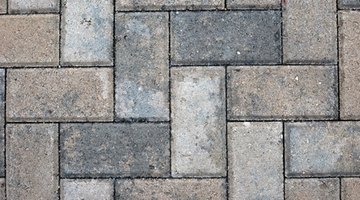How to Make a Brick Ramp
Building codes require that ramps rise in height no more than 1 inch for every 12 inches of length. Consider this requirement when choosing the style of ramp to build.

Brick ramps could be made as part of the landscape so that it appears to be a gently sloping sidewalk from the driveway to the door or as a structural ramp. Consider the area where the ramp is going to be built to determine the shape it should be built. Ramps can be straight, switchback, U-shaped or L-shaped as needed to fit into the landscaping.
Things You Will Need
- Building permit
- Rise measurement
- Damp diagram or design
- Wooden stakes
- Hammer
- Marker
- Shovel
- Dirt as needed
- 2 by 4 piece of wood – 4 feet long
- 2 by 6 redwood planks
- Gravel
- Tamper
- Sand
- Bricks
- Rubber head hammer
- Broom
Planning and Preparing
-
Contact local city building code agencies for instructions on getting and posting building permits. Complete all required paperwork and post the permit according to local laws.
-
Determine the rise in inches from the top of the step to the bottom of the ramp. Multiply this measurement by 12 to determine the length of the ramp. If the step is 12 inches high the ramp will need to be 144 inches long. Choose the shape of the ramp. Bricks allow for curves if desired, but the width should always be 4 feet wide unless building codes specify a different width.
-
Choose the bricks and the pattern to be used when laying them. Bricks come in a variety of colors and sizes. Choose a size that will require the least amount of cutting to make the construction easier. Calculate the number of bricks needed for the project.
Constructing the Ramp
-
Mark the sides of the ramp with stakes placed every 6 inches along the chosen path. Mark the top of every other stake so the 12-inch measurement is easily identified. Dig out or fill in soil as needed to create a base for the bricks. Once completed the brick will rise 6 inches above this base.
-
Smooth the graded area by pulling the 2 by 4 length of wood across the ramp area. Set a level on top of the wood to verify the ramp doesn’t tilt to one side or another. Add or remove dirt as needed until the ramp is level along its entire length. Verify the rise of the ramp does not exceed building code requirements. Install the lengths of 2 by 6 redwood along the stakes as edging.
-
Spread a layer of gravel 3 to 4 inches thick over the dirt. Tamp this gravel firmly. Lay a ½ inch layer of sand over this gravel. Place the level on top of the 2 by 4 piece of wood and pull across the ramp to verify it is level across the entire ramp.
-
Lay the bricks on the sand gently, beginning at the top of the ramp. The bricks will be sitting slightly higher than the step as they will settle. Tamp each brick firmly with a rubber mallet as it is laid in place. Lay the bricks that do not need to be cut all the way to the end of the ramp before returning to the top to lay the cut bricks.
-
Cover the bricks with a thin layer of sand and gently sweep this sand into the joints between the bricks. Add landscaping to the sides of the ramp as needed to hold soil in place or integrate the ramp into the overall landscaping.
The Drip Cap
- Building codes require that ramps rise in height no more than 1 inch for every 12 inches of length.
- Consider the area where the ramp is going to be built to determine the shape it should be built.
- Mark the sides of the ramp with stakes placed every 6 inches along the chosen path.
- Dig out or fill in soil as needed to create a base for the bricks.
- Install the lengths of 2 by 6 redwood along the stakes as edging.
- Spread a layer of gravel 3 to 4 inches thick over the dirt.
- Place the level on top of the 2 by 4 piece of wood and pull across the ramp to verify it is level across the entire ramp.
References
Writer Bio
Based in Minneapolis, Dawn Marcotte has been writing for more than 10 years. Her recent writing has turned to nonfiction and includes articles on home and garden, education, crafts and automotive subjects. She currently has several eBooks published and available online. Marcotte has a Bachelor of Science in elementary education from the University of Iowa.
Photo Credits
- bricks image by Ann Kosche from Fotolia.com
- bricks image by Ann Kosche from Fotolia.com
More Articles



